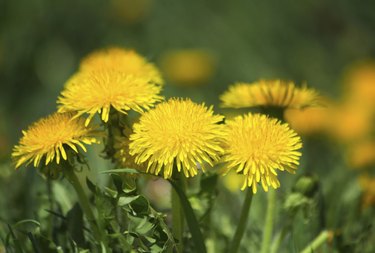
The dandelion (Taraxacum officinale) belongs to the daisy family and is easily recognized by its sunny yellow flower head. Later, the blossom is replaced by a sphere of several hundred seeds that "parachute" with the wind, a feature that delights most children and annoys gardeners. It occurs naturally in U.S. Department of Agriculture plant hardiness zones 5 through 9.
Because there are other flowers that look like dandelions, it's not always easy to tell the difference between an imposter and the real thing. Awareness of the structural differences and growth habits of these plants will help with identification.
Video of the Day
Video of the Day
Identifying Dandelion Plants
Dandelion is a weedy perennial in the same family as aster and sunflower. Because the plant thrives in any kind of soil, isn't fussy about pH and tolerates drought, it thrives in roadside gravel or between patio blocks as well as in open pastures.
The yellow flowers emerge in spring and transform in late summer into seed heads that enable the plant to colonize when the wind blows, so it can be invasive in some places, notes the University of California. The leaves are opposite and elongated with notches or "teeth," and the stems contain a milky latex sap that flows when cut or broken.
Common Cat’s Ear
This broadleaf perennial is an invasive weed commonly found in pastures, meadows and other disturbed places in USDA zones 4 through 8, according to Plants for a Future. Cat's ear (Hypochaeris radicata) produces a yellow flower rosette and has toothed leaves and a long taproot. The plant that looks like a dandelion in almost every way except dandelion stems only reach 6 to 12 inches high while cat's ear has branched, hairy stems that can grow to more than 3 feet high, notes the University of California.
Meadow Hawkweed Plants
Also known as yellow hawkweed and yellow paintbrush, meadow hawkweed (Hieracium caespitosum) is an invasive European species now naturalized throughout USDA zones 2 through 8. As with dandelion, the plant exudes a milky latex sap.
In contrast, however, the leaves of meadow hawkweed are narrower and longer and are without "teeth." Also, the plant produces clusters of yellow flowers on 14- to 36-inch stems, while dandelion flowers appear singularly on stems roughly half as tall.
Common Sowthistle Plants
Common sowthistle (Sonchus oleraceus), also called annual sowthistle, inhabits open fields and meadows in USDA zones 4 through 7. It is sometimes mistaken for dandelion because it has a yellow daisy-like flower and alternate toothed leaves and tends to be invasive in open areas. The plant's stems also discharge a milky sap, according to the University of California. The leaves, however, are triangular-shaped and more deeply lobed than the leaves of true dandelions.
Lesser Hawkbit Plants
Also known as rough hawkbit and bristly hawkbit, lesser hawk bit (Leontodon hispidus) is an invasive perennial wildflower original to Europe and the Middle East that now occurs naturally in USDA zones 5-9, adivses Plants for a Future.
Among look-alikes, this species shares more common features with dandelion than most. The stems support single yellow flower heads that go to seed and release a milky sap when broken. The distinguishing feature is in the leaves, which are elongated and toothed like those of dandelion but are considerably narrower.
Landscape Weed Control
Several safe and effective methods exist to eliminate dandelions and similar weeds. If plants have not yet gone to seed, simply pulling them out with a firm grasp at the base of the plant is sufficient. Pull straight up to get as much of the taproot as possible, loosening the soil first if necessary. Alternately, placing a layer of clear plastic over newly sprouted plants for a few weeks allows the sun to "bake" them, leaving the space weed-free.
Finally, plan to take a more active approach each spring by placing generous amounts of mulch around bedding plants and shrubs to deter invading plants, advises the University of California. If weeds tend to spring up in the same patch of an established lawn or perennial garden each year, spread a layer of corn gluten meal in these spots to prevent seed germination.